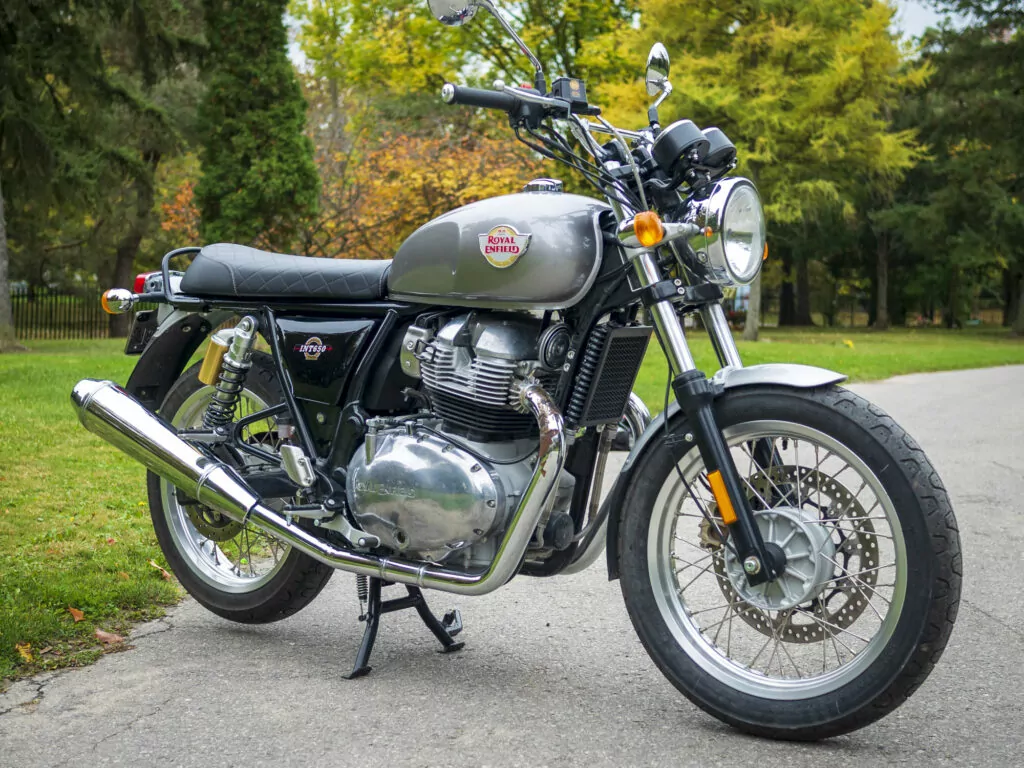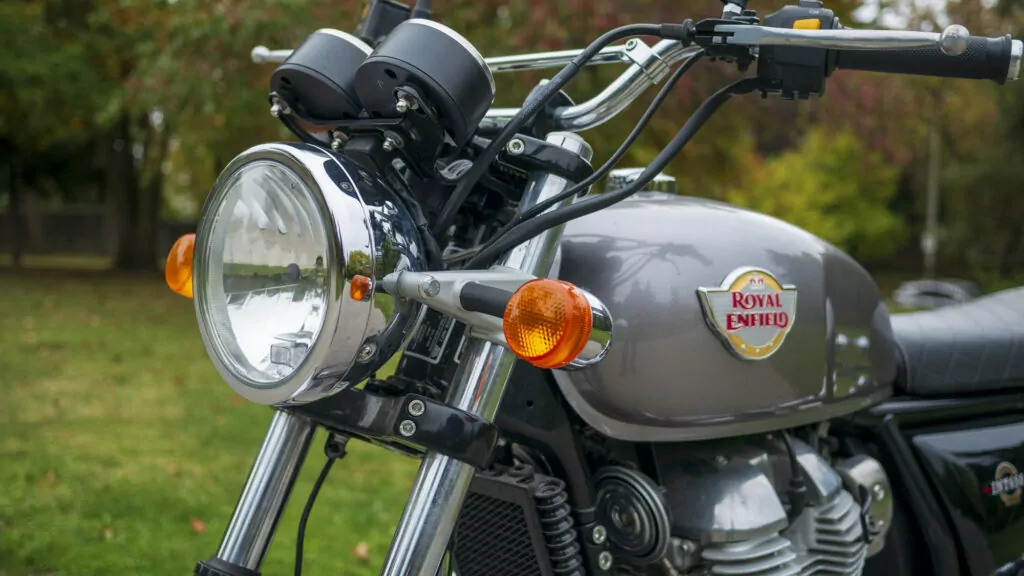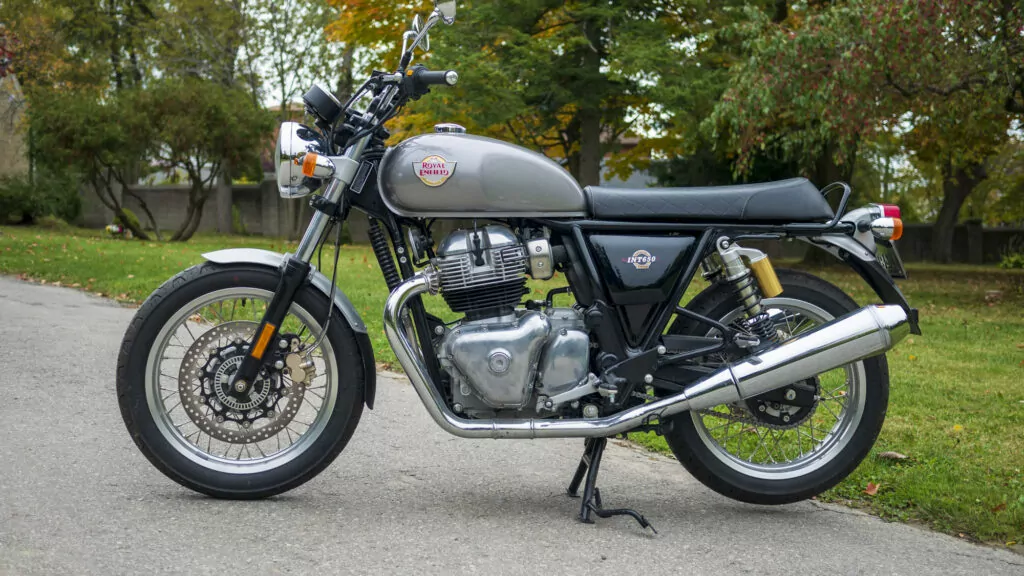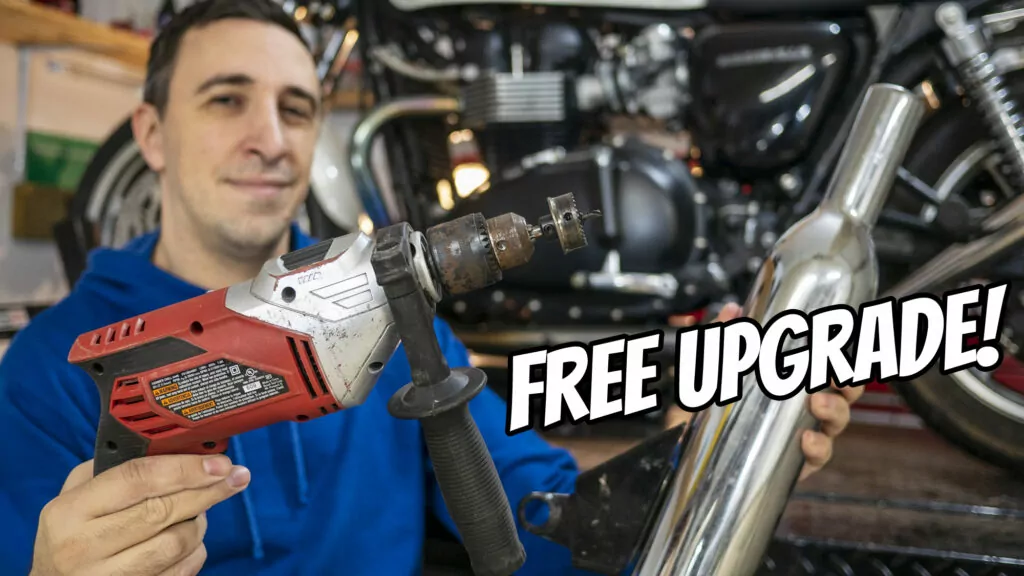Welcome to the second video in my series comparing the Royal Enfield Interceptor 650, vs the Triumph Bonneville, vs the Moto Guzzi V7. A couple years ago I made a video of my first impressions riding an Interceptor 650. Now that I own one, I realize that I got a few things wrong!
Today I want to look back at that video and talk about:
- What shaped my opinion of Royal Enfield up until that point, and how it might have changed.
- What I realize I got wrong about the Interceptor 650 now that I own one.
- What I got right about the Interceptor 650 too, to try to give you guys an honest and well rounded picture of what the Interceptor 650 is all about.
Finally, we’ll talk about how my opinion of the Interceptor 650 may have changed as an owner of this bike, and what’s next in my Interceptor, V7, Bonneville comparison series.
I’m Adrian from YouMotorcycle. I make videos that help motorcyclists. These are my thoughts on the Interceptor 650.


Royal Enfield Interceptor 650 Review – Introduction
I want you to put on your imagination hat. The year is 2022. Every Royal Enfield employee and fanboy on the internet seemed to say the same thing: “This company has improved so much, reliability isn’t a problem anymore, this company is nothing like what it used to be.”
… and I was skeptical.
About a decade earlier I was working for a dealership in the motorcycle industry, and Royal Enfield had a bad reputation. But when the new Bullet 500s came out with EFI, all we could hear from Royal Enfield and its fanboys was: “This company has improved so much, reliability isn’t a problem anymore, this company is nothing like what it used to be.” Why does this sound familiar?
And of course, we all know how great the Bullet 500 turned out to be. And for those who don’t know, well, the answer is not very great.
But I decided to give Royal Enfield the benefit of the doubt, and take the Interceptor for a second test ride a year later. This time, I liked it so much, that I bought one! And that’s when I started to realize that I got a few things wrong about the Interceptor 650.

What I got WRONG about the Royal Enfield Interceptor 650
Let’s talk about what I got wrong about the Interceptor 650.
1) I said the bike was “boring” and “lacking in any particular set of character traits that would make it easy to talk about.” – I was trying to be a little funny but I also kind of believed it at the time. Luckily, with the luxury of having a lot more time with the Interceptor I realized now that “old school chill” is a personality type. The problem is that this motorcycle is not at all exciting, and as a result it’s quick to assume it’s lacking character, but that’s not the case.
Compared to my 865cc air cooled Triumph Bonneville, the Interceptor is lacking a lot of horsepower and torque, as a result, it’s a lot less exciting to ride than my Bonneville. However, the Bonneville is completely lacking personality. It’s extremely bland. In contrast, the Interceptor does have character, it’s just a very laid back old school mellow personality, but not an exciting one.
2) “Highway: I feel like RPMs are going to be buzzing like crazy.” – I was totally wrong about this. As long as you’re comfortable just cruising at a comfortable 70 miles per her or 120 km/hr the Royal Enfield Interceptor is fine on the highway. If you’re not expecting your Interceptor 650 to be a fast motorcycle, because it totally isn’t compared to other 650 cc motorcycles, if speed isn’t want you’re looking for, you’ll be totally fine having a ride on the highway at a relaxed pace. It’s not a fast machine, but you can ride it in the powerband comfortably at highway speeds, or you can put it in sixth gear which is a bit of an over drive gear and just relax.
3) “Not as nimble as the Triumph Bonneville SE” – A lot of people didn’t realize that the Triumph Bonneville SE used a 17″ mag wheel. Here’s a quick back story, from 2001 until around 2016, Triumph equipped most Bonnevilles with a 19″ front wheel and they didn’t handle that great. But some models, like the SE, came with a 17″ mag wheel instead. The smaller front and rear tires on the Bonneville SE models were similar in size to sport bikes and sport oriented street bikes, meaning you could get some very nimble handling and some very sticky tires.
I assumed that because of the smaller tire size and wide availability of sticky tire options, the Bonneville SE would handle better. In perfect conditions, like a nicely paved race track, that would be the case. The problem is that my 2009 Bonneville SE’s original suspension is awful. The suspension on the Royal Enfield Interceptor 650 has much better suspension. So in perfect situations the Bonneville SE does handle much better, but the reality is we live in an imperfect, bumpy world, so in many cases the Interceptor 650 actually handles better.

What I got RIGHT about the Interceptor 650
Ok, now that I’ve eaten humble pie a little bit and admitted what I was wrong about, let’s talk about what I got right about the Royal Enfield Interceptor 650.
1) “Easy handling” – I mentioned that this bike had easy handling and was not hard to ride. I stand by that. The Royal Interceptor 650, right out of the box, handles great. It’s a very beginner friendly motorcycle.
I also took an extended test ride on the Continental GT, and I definitely prefer the handling on the Interceptor 650 over the Royal Enfield Continental GT.
2) “It does shift very smooth. It does feel very smooth.” – It absolutely does both. The shift linkage is something that you might want to adjust to make sure it fits your footwear, especially if you have bigger feet and ride in boots. The nice thing is that the shift lever is adjustable, and once it’s set up for your size, the Interceptor shifts smoothly and it feels great.
Pause for a second – This isn’t something that I mentioned in my video but it’s something I’ve come to learn about the Enfield in the time I’ve owned one. It’s very endearing. It’s like a girlfriend that isn’t the hottest, isn’t the wildest, isn’t the smartest, isn’t the hardest working, but she’s just such an easy-going, agreeable, friendly sweetheart of a motorcycle that she wins your heart over anyway.
3) “It’s hard to know just from looking if something is going to pit prematurely.” – I can’t believe that I was riding a brand new motorcycle, and was already concerned about whether or not this motorcycle would suffer from premature pitting. Because guess what? My Royal Enfield Interceptor 650 is totally suffering from premature pitting on the engine sidecases!
I talked to another local Interceptor owner that I used to work together with at a motorcycle dealership, and he told me it’s a known issue and that Enfield doesn’t do anything to seal the engine cases so they all get like that with time. It’s oxidation and it can’t be avoided.
I just wanna point out how crazy this is, because earlier this year I had a 2001 Triumph Bonneville with no pitting on the engine side cases. I did a full video and article comparing the finish on the 20 year old Triumph versus the 10 year old Royal Enfield so I won’t get into that too much, but I’ll go on to say that even my nearly 50 year old Honda CL350 had no pitting on the side cases, and it’s embarassing that Royal Enfield can’t figure out a way to do what Honda has been able to get right for almost half a century.
4) “It’s not the prettiest motor.” – To me, the motor is still ugly. The fact that it’s so many different colors still wreaks of cutting corners to save costs. Essentially, the Interceptor 650’s motor is a handful of different colors, and that’s to save money. When you have different materials all being made to different specifications, it costs less money to finish each one individually than it does to make all of those materials to the same quality of finish.

Conclusions and what comes next
Obviously a new Interceptor costs about 80% of what a new Triumph Bonneville or Moto Guzzi V7 cost, so we have to expect corners being cut somewhere. I’m not telling you all this just to dump on my Interceptor, I’m doing a series comparing my Interceptor vs my Bonneville vs my V7, and it’s only right to give you the most honest and well-rounded reviews of each motorcycle that I can give you.
If it seems like I’m showing any kind of bias or favoritism, don’t worry, because all three of these motorcycles are going to have their turn being both praised and crucified by me. If you want to come along for the ride, be sure to subscribe to YouMotorcycle on YouTube.
Overall the Interceptor is a pretty good motorcycle, and now that I’ve owned one for a while I realize it’s better than I thought it would be. But it’s still a budget motorcycle. I don’t want you buying it under the expectation that you will get the same level of quality and performance as you would from Moto Guzzi or Triumph for a lesser price, because you won’t. That’s not what this motorcycle is about.
The Interceptor 650 is about providing a positive motorcycle riding experience with great handling, smooth an easy shifting, and a relaxed motor. The Royal Enfield’s motor might not be fast, but is capable enough to cover your needs. The overall package is a solid option, the motorcycle is endearing. The more you ride it, the more you’ll like it, and the more you’ll probably be able to forgive her for her shortcomings… unless you’re really picky.
If you can find one of these for a cheap price they can be a pretty good beginner to intermediate level motorcycle . But if you’re a pickier rider, or looking for something more advanced, unless you’ve found a really great deal – I bought mine with a few hundred miles for $3650 – you might want to keep looking.
My next few videos are going to be about my Triumph Bonneville and my Moto Guzzi V7, introducing you guys to the bikes and then trying to address some of the shortcomings of each one. I have a maximum budget that I can spend upgrading the weaknesses of each motorcycle, so we’ll see how that plays out.
After a couple upgrades, I’ll be selling whichever one of the these three motorcycles I like the least. The series will continue after that with the other two for motorcycles for another round of mods and upgrades before we crown a winner.
If you’re interested, remember to subscribe to YouMotorcycle on YouTube. As always, thank you guys for watching, it really means a lot. The reaction I got on the first video of this series was amazing and I appreciate you guys hanging out with me!
Adrian
Check out the next video in the series by clicking the image below:

 YouMotorcycle Motorcycle Blog – Motorcycle Lifestyle Blog, MotoVlog, Motorcycle Reviews, News, & How-Tos
YouMotorcycle Motorcycle Blog – Motorcycle Lifestyle Blog, MotoVlog, Motorcycle Reviews, News, & How-Tos

Awesome video Adrian. I totally dig seeing how bikes age! The chrome on my ’79 KZ650SR is still pretty sweet, and my ’05 Vulcan 800’s chrome is still looking top-notch. I’d be seriously ticked if it started getting all pitted and foggy like that in just a few years.
Your best video yet. I own one of these but I won’t say which one. Stoked to hear what you think about all three of them.
Those three bikes are literally the ones I’m torn between choosing. 😁 I’ve got a soft spot for the Bonnie, but it’ll really depend on what deal I stumble upon. Thanks a bunch for your videos. Great serie!